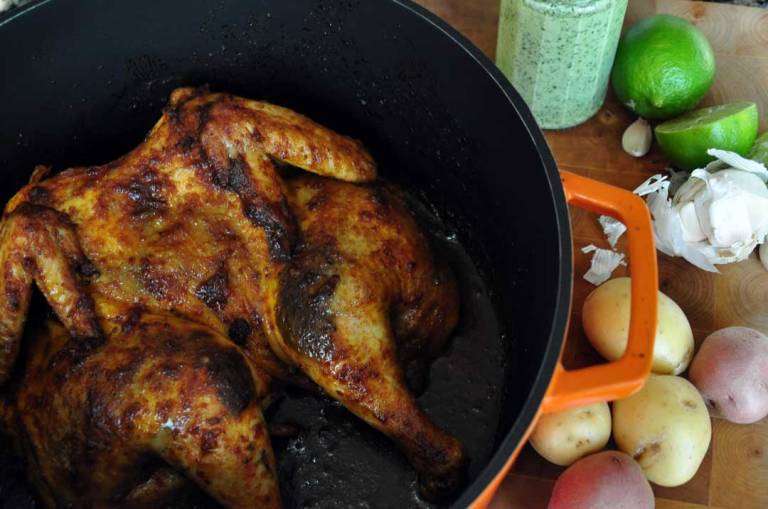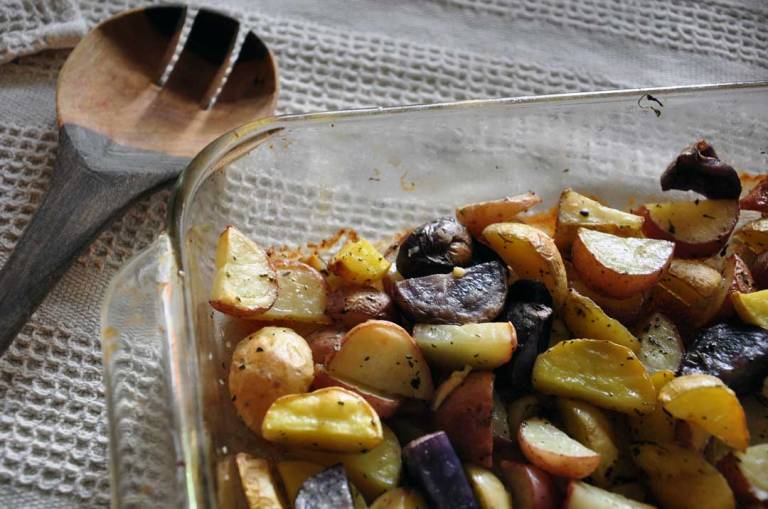- Spatchcocked roast chicken with paprika-cumin spice rub
- Papas al oregano (oven-roasted potatoes with garlic and oregano)
- Peruvian aji mayonnaise (cilantro and lime–speckled mayonnaise)
- Torta de Bruselina (multilayered chocolate and whipped cream cake)
Suspiro de Limeña.
If you’ve wondered what’s taken so long for me to return and wax lyrical about our vicarious gastronomical adventures, it’s this: Suspiro de Limeña.
It translates plainly as “sigh of Lima,” but I’ve seen it as “sigh of a woman from Lima,” or “a Lima-style sigh.” It’s the name of a dessert—the very first possibility I encountered in my search for dishes that are distinctly Peruvian—a dessert with two layers: manjar blanco, made by barely simmering condensed milk, an egg yolk, and vanilla until a soft caramel emerges; and topped with a sharp-peaked cloud of meringue foam that is scented with port wine and a sprinkle of cinnamon—a dessert whose poetic name was first pronounced by Peruvian writer Jose Galvez in the mid-nineteenth century, to the delight of his wife Amparo Ayarez, who is credited with creating the confection.
It’s the idea of this sigh, the long poetic culinary exhale, that terrified me into silence.
Not because I’m not up to the challenge, but because it suddenly hit me that my description of the food from large diverse lands like Peru may be tepid—completely devoid of the beauty and joy that food represents to the world of which I write, a dreamed ecstasy that may or may not be accurate. The epiphany that the vicarious experience may appear complex and authentic, but it is, at best, bland. Unseasoned. Insipid.
I mustered the courage to revisit the blog after walking around San Francisco and ingesting (on consecutive days) a bowl of Thai panang curry (a Laotian import), Japanese beef ramen (which traces distinctly Chinese origins), a vegan pot au feu at an upscale Swedish restaurant, a bánh mì sandwich (can you say “Indochine”?), and mint “mojito” coffee at a happy California cafe (thank you, Amisha and Chintu!).
The memory it reignited was powerful, too: In 2008, though we speak little Spanish, my husband and I spent an incredible evening in the belly of Buenos Aires, Argentina, trying to locate a “secret” Japanese-Peruvian restaurant (our only clue was that its signage was emblazoned with a dragonfly). Our imagination will forever be engorged with the quinoa-crusted sushi and aji sashimi on which we feasted that day. My only other encounter with the captivating myth that is Peruvian food was in Chile, where Santiaguinos swore that the best food in the country was Peruvian (I disagree, but my reasons shall be reserved for another post).
What it means is that food is no more authentic than is language.
In fact—and especially in Peru’s case—a gastronomic heritage is usually constructed. An interesting piece from the Anthropology of Food claims that Peru’s government decisively ignited the nation’s gastronomic “revolution” in October 2007, aiming to make food a means of identity for the ancient land marked by great diversity of spirit and space, indigenous and urban, from coastal desert, the Andean highlands, to the swaying Amazon rainforest, transforming its fractured history into the greatest story of consensus and social inclusion. There’s an economic reason for the valorization of Peru’s culinary reputation, and it’s a gastronomic discourse that continues to evolve. It’s why ceviche isn’t any more emblematic of Peru than is kiwicha.
Suspiro.
So, when the little guy proclaimed Peru was his pick for International Thursday, the resulting menu retained the simplicity, the authenticity, that has come to characterize our own experiences, and is embedded in other ThisisaKeeper posts.
Ceviche would have been a nice addition, but we went instead with a spatchcocked roast chicken rubbed liberally with a smokey spice paste of pungent garlic, cumin and paprika, bright oregano, and lemon peel. Our treasured lesson was how to spatchcock a bird—removing the spine allows the bird to roast evenly and quickly. This, we served with an absolute keeper aji, which is an incredibly simple yet delectable vibrant green dipping sauce comprised of blended cilantro, jalapenos, garlic, lime juice, oil, and mayonnaise.

And in homage to the Inca Indians in Peru, who were the first known cultivators (as early as 8,000 B.C.) of what has become a mind-boggling variety of potatoes (Peru alone has 3,800 varieties), our side was a papa medley, dressed lightly with sliced garlic and minced oregano.

Suspiro de Limeña would have absolutely made for a gorgeous photo, but in the end, I shied from the idea of using a raw egg-white meringue. An attempt to find cherimoya—also known as a “custard apple,” widely available in East Africa and throughout South Asia, but still a mystery here in Houston—failed, and so collapsed my fantasy to construct a cherimoya semifreddo. Perhaps that will appear if my little guy ever turns his eye towards Asia.
Instead, we went for the extraordinary looking torta de Bruselina, a confection that was reportedly popular in Lima’s upscale restaurants until it fell out of favor, presumably displaced by the array of new inventions that sample the country’s vast range of indigenous fruit and much-exported cacao beans.

To me, the seven-layer dessert will always be a classic. The chocolate layers are actually more cookie-like, slightly crunchy on the edges yet still soft in the centers, and when chilled, absorb the moisture from the puffs of vanilla-scented whipped cream that separate them. A forkful yields a dense mouthful that still offers the occasional crunch from a renegade “cookie” fragment, yet creamy, sweet and bitter balanced perfectly. I added the extra element of a espresso-laced ganache, and we all decided that each layer could benefit from a quick brush of black coffee.
But that can wait until the next time. For now, I can truly exhale.

Interesting!!
LikeLike